Management > QUESTIONS & ANSWERS > CH 02 - An Introduction to Linear Programming. Questions and Answers (All)
CH 02 - An Introduction to Linear Programming. Questions and Answers
Document Content and Description Below
/ 1. In a linear programming problem, the objective function and the constraints must be linear functions of the decision variables. a. b. : POINTS: 1 DIFFICULTY: Easy LEARNIN... G OBJECTIVES: IMS.ASWC.19.02.01 - 2.1 NATIONAL STANDARDS: United States - BUSPROG: Reflective Thinking TOPICS: 2.1 A Simple Maximization Problem KEYWORDS: Bloom's: Remember 2. Only binding constraints form the shape (boundaries) of the feasible region. a. b. : POINTS: 1 DIFFICULTY: Easy LEARNING OBJECTIVES: IMS.ASWC.19.02.02 - 2.2 NATIONAL STANDARDS: United States - BUSPROG: Reflective Thinking TOPICS: 2.2 Graphical Solution Procedure KEYWORDS: Bloom's: Remember 3. It is not possible to have more than one optimal solution to a linear programming problem. a. b. : POINTS: 1 DIFFICULTY: Easy LEARNING OBJECTIVES: IMS.ASWC.19.02.02 - 2.2 NATIONAL STANDARDS: United States - BUSPROG: Reflective Thinking TOPICS: 2.2 Graphical Solution Procedure KEYWORDS: Bloom's: Understand 4. A linear programming problem can be both unbounded and infeasible. a. b. : POINTS: 1 DIFFICULTY: Easy LEARNING OBJECTIVES: IMS.ASWC.19.02.06 - 2.6 NATIONAL STANDARDS: United States - BUSPROG: Reflective Thinking TOPICS: 2.6 Special Cases KEYWORDS: Bloom's: Understand 5. An infeasible problem is one in which the objective function can be increased to infinity. a. b. : POINTS: 1 DIFFICULTY: Easy LEARNING OBJECTIVES: IMS.ASWC.19.02.06 - 2.6 NATIONAL STANDARDS: United States - BUSPROG: Reflective Thinking TOPICS: 2.6 Special Cases KEYWORDS: Bloom's: Understand 6. An unbounded feasible region might not result in an unbounded solution for a minimization or maximization problem. a. b. : POINTS: 1 DIFFICULTY: Easy LEARNING OBJECTIVES: IMS.ASWC.19.02.06 - 2.6 NATIONAL STANDARDS: United States - BUSPROG: Reflective Thinking TOPICS: 2.6 Special Cases KEYWORDS: Bloom's: Understand 7. An optimal solution to a linear programming problem can be found at an extreme point of the feasible region for the problem. a. b. : POINTS: 1 DIFFICULTY: Easy LEARNING OBJECTIVES: IMS.ASWC.19.02.03 - 2.3 NATIONAL STANDARDS: United States - BUSPROG: Reflective Thinking TOPICS: 2.3 Extreme Points and the Optimal Solution KEYWORDS: Bloom's: Understand 8. The optimal solution to any linear programming problem is the same as the optimal solution to the standard form of the problem. a. b. : POINTS: 1 DIFFICULTY: Easy LEARNING OBJECTIVES: IMS.ASWC.19.02.01 - 2.1 NATIONAL STANDARDS: United States - BUSPROG: Reflective Thinking TOPICS: 2.1 A Simple Maximization Problem KEYWORDS: Bloom's: Understand 9. The constraint 2x1 − x2 = 0 passes through the point (200, 100). a. b. : POINTS: 1 DIFFICULTY: Moderate LEARNING OBJECTIVES: IMS.ASWC.19.02.02 - 2.2 NATIONAL STANDARDS: United States - BUSPROG: Analytic TOPICS: 2.2 Graphical Solution Procedure KEYWORDS: Bloom's: Understand 10. The point (3, 2) is feasible for the constraint 2x1 + 6x2 ≤ 30. a. b. : POINTS: 1 DIFFICULTY: Moderate LEARNING OBJECTIVES: IMS.ASWC.19.02.02 - 2.2 NATIONAL STANDARDS: United States - BUSPROG: Analytic TOPICS: 2.2 Graphical Solution Procedure KEYWORDS: Bloom's: Understand 11. No matter what value it has, each objective function line is parallel to every other objective function line in a problem. a. b. : POINTS: 1 DIFFICULTY: Easy LEARNING OBJECTIVES: IMS.ASWC.19.02.02 - 2.2 NATIONAL STANDARDS: United States - BUSPROG: Reflective Thinking TOPICS: 2.2 Graphical Solution Procedure KEYWORDS: Bloom's: Understand 12. Constraints limit the degree to which the objective in a linear programming problem is satisfied. a. b. : POINTS: 1 DIFFICULTY: Easy LEARNING OBJECTIVES: IMS.ASWC.19.02.01 - 2.1 NATIONAL STANDARDS: United States - BUSPROG: Reflective Thinking TOPICS: 2.1 A Simple Maximization Problem KEYWORDS: Bloom's: Remember 13. Alternative optimal solutions occur when there is no feasible solution to the problem. a. b. : POINTS: 1 DIFFICULTY: Easy LEARNING OBJECTIVES: IMS.ASWC.19.02.06 - 2.6 NATIONAL STANDARDS: United States - BUSPROG: Reflective Thinking TOPICS: 2.6 Special Cases KEYWORDS: Bloom's: Understand 14. Because surplus variables represent the amount by which the solution exceeds a minimum target, they are given positive coefficients in the objective function. a. b. : POINTS: 1 DIFFICULTY: Moderate LEARNING OBJECTIVES: IMS.ASWC.19.02.01 - 2.1 NATIONAL STANDARDS: United States - BUSPROG: Reflective Thinking TOPICS: 2.1 A Simple Maximization Problem KEYWORDS: Bloom's: Understand 15. A redundant constraint cannot be removed from the problem without affecting the feasible region. a. b. : POINTS: 1 DIFFICULTY: Easy LEARNING OBJECTIVES: IMS.ASWC.19.02.02 - 2.2 NATIONAL STANDARDS: United States - BUSPROG: Reflective Thinking TOPICS: 2.2 Graphical Solution Procedure KEYWORDS: Bloom's: Understand 16. The constraint 5x1 − 2x2 ≤ 0 passes through the point (20, 50). a. b. : POINTS: 1 DIFFICULTY: Moderate LEARNING OBJECTIVES: IMS.ASWC.19.02.02 - 2.2 NATIONAL STANDARDS: United States - BUSPROG: Reflective Thinking TOPICS: 2.2 Graphical Solution Procedure KEYWORDS: Bloom's: Understand 17. At a problem's optimal solution, a redundant constraint will have zero slack. a. b. : POINTS: 1 DIFFICULTY: Easy LEARNING OBJECTIVES: IMS.ASWC.19.02.02 - 2.2 NATIONAL STANDARDS: United States - BUSPROG: Reflective Thinking TOPICS: 2.2 Graphical Solution Procedure KEYWORDS: Blooms: Understand 18. If a constraint is redundant, it can be removed from the problem without affecting the feasible region. a. b. : POINTS: 1 DIFFICULTY: Easy LEARNING OBJECTIVES: IMS.ASWC.19.02.02 - 2.2 NATIONAL STANDARDS: United States - BUSPROG: Reflective Thinking TOPICS: 2.2 Graphical Solution Procedure KEYWORDS: Bloom's: Understand 19. For a minimization problem, the solution is considered to be unbounded if the value may be made infinitely small. a. b. : POINTS: 1 DIFFICULTY: Easy LEARNING OBJECTIVES: IMS.ASWC.19.02.06 - 2.6 NATIONAL STANDARDS: United States - BUSPROG: Reflective Thinking TOPICS: 2.6 Special Cases KEYWORDS: Bloom's: Remember Multiple Choice 20. The maximization or minimization of a desired quantity is the a. goal of management science. b. decision for decision analysis. c. constraint of operations research. d. objective of linear programming. : d POINTS: 1 DIFFICULTY: Easy LEARNING OBJECTIVES: IMS.ASWC.19.02.01 - 2.1 NATIONAL STANDARDS: United States - BUSPROG: Reflective Thinking TOPICS: 2.1 A Simple Maximization Problem KEYWORDS: Bloom's: Remember 21. Decision variables a. are values that are used to determine how much or how many of something to produce, invest, etc. b. represent the values of the constraints. c. are values that measure the objective function. d. must be unique for each constraint. : a POINTS: 1 DIFFICULTY: Easy LEARNING OBJECTIVES: IMS.ASWC.19.02.01 - 2.1 NATIONAL STANDARDS: United States - BUSPROG: Reflective Thinking TOPICS: 2.1 A Simple Maximization Problem KEYWORDS: Bloom's: Understand 22. Which of the following is a valid objective function for a linear programming problem? a. Min 8xy b. Min 4x + 3y + (1/2)z c. Min 5x2 + 6y2 d. Max (x1 + x2)/x3 : b POINTS: 1 DIFFICULTY: Easy LEARNING OBJECTIVES: IMS.ASWC.19.02.01 - 2.1 NATIONAL STANDARDS: United States - BUSPROG: Reflective Thinking TOPICS: 2.1 A Simple Maximization Problem KEYWORDS: Bloom's: Understand 23. Which of the following statements is NOT ? a. A feasible solution satisfies all constraints. b. An optimal solution satisfies all constraints. c. An infeasible solution violates all constraints. d. A feasible solution point does not have to lie on the boundary of the feasible region. : c POINTS: 1 DIFFICULTY: Easy LEARNING OBJECTIVES: IMS.ASWC.19.02.02 - 2.2 NATIONAL STANDARDS: United States - BUSPROG: Reflective Thinking TOPICS: 2.2 Graphical Solution Procedure KEYWORDS: Bloom's: Understand 24. When no solution to the linear programming problem satisfies all the constraints, including the nonnegativity conditions, it is considered a. optimal. b. feasible. c. infeasible. d. semifeasible. : c POINTS: 1 DIFFICULTY: Moderate LEARNING OBJECTIVES: IMS.ASWC.19.02.06 - 2.6 NATIONAL STANDARDS: United States - BUSPROG: Reflective Thinking TOPICS: 2.6 Special Cases KEYWORDS: Bloom's: Understand 25. The amount by which the left side of a less-than-or-equal-to constraint is smaller than the right side a. is known as a surplus. b. is known as slack. c. is optimized for the linear programming problem. d. exists for each variable in a linear programming problem. : b POINTS: 1 DIFFICULTY: Easy LEARNING OBJECTIVES: IMS.ASWC.19.02.02 - 2.2 NATIONAL STANDARDS: United States - BUSPROG: Reflective Thinking TOPICS: 2.2 Graphical Solution Procedure KEYWORDS: Bloom's: Understand 26. To find the optimal solution to a linear programming problem using the graphical method, a. find the feasible point that is the farthest away from the origin. b. find the feasible point that is at the highest location. c. find the feasible point that is closest to the origin. d. None of these are correct. : d POINTS: 1 DIFFICULTY: Easy LEARNING OBJECTIVES: IMS.ASWC.19.02.03 - 2.3 NATIONAL STANDARDS: United States - BUSPROG: Reflective Thinking TOPICS: 2.3 Extreme Points and the Optimal Solution KEYWORDS: Blooms: Understand 27. Which of the following special cases does NOT require reformulation of the problem in order to obtain a solution? a. alternative optimality b. infeasibility c. unboundedness d. Each case requires a reformulation. : a POINTS: 1 DIFFICULTY: Moderate LEARNING OBJECTIVES: IMS.ASWC.19.02.06 - 2.6 NATIONAL STANDARDS: United States - BUSPROG: Reflective Thinking TOPICS: 2.6 Special Cases KEYWORDS: Bloom's: Understand 28. Infeasibility means that the number of solutions to the linear programming models that satisfies all constraints is a. at least 1. b. 0. c. an infinite number. d. at least 2. : b POINTS: 1 DIFFICULTY: Easy LEARNING OBJECTIVES: IMS.ASWC.19.02.06 - 2.6 NATIONAL STANDARDS: United States - BUSPROG: Reflective Thinking TOPICS: 2.6 Special Cases KEYWORDS: Bloom's: Remember 29. A constraint that does NOT affect the feasible region of the solution is a a. nonnegativity constraint. b. redundant constraint. c. standard constraint. d. slack constraint. : b POINTS: 1 DIFFICULTY: Easy LEARNING OBJECTIVES: IMS.ASWC.19.02.02 - 2.2 NATIONAL STANDARDS: United States - BUSPROG: Reflective Thinking TOPICS: 2.2 Graphical Solution Procedure KEYWORDS: Bloom's: Remember 30. Whenever all the constraints in a linear program are expressed as equalities, the linear program is said to be written in a. standard form. b. bounded form. c. feasible form. d. alternative form. : a POINTS: 1 DIFFICULTY: Easy LEARNING OBJECTIVES: IMS.ASWC.19.02.02 - 2.2 NATIONAL STANDARDS: United States - BUSPROG: Reflective Thinking TOPICS: 2.2 Graphical Solution Procedure KEYWORDS: Bloom's: Remember 31. All of the following statements about a redundant constraint are correct EXCEPT a. a redundant constraint does not affect the optimal solution. b. a redundant constraint does not affect the feasible region. c. recognizing a redundant constraint is easy with the graphical solution method. d. at the optimal solution, a redundant constraint will have zero slack. : d POINTS: 1 DIFFICULTY: Moderate LEARNING OBJECTIVES: IMS.ASWC.19.02.02 - 2.2 NATIONAL STANDARDS: United States - BUSPROG: Reflective Thinking TOPICS: 2.2 Graphical Solution Procedure KEYWORDS: Bloom's: Understand 32. All linear programming problems have all of the following properties EXCEPT a. a linear objective function that is to be maximized or minimized. b. a set of linear constraints. c. alternative optimal solutions. d. variables that are all restricted to nonnegative values. : c POINTS: 1 DIFFICULTY: Moderate LEARNING OBJECTIVES: IMS.ASWC.19.02.01 - 2.1 NATIONAL STANDARDS: United States - BUSPROG: Reflective Thinking TOPICS: 2.1 A Simple Maximization Problem KEYWORDS: Bloom's: Understand 33. If there is a maximum of 4,000 hours of labor available per month and 300 ping-pong balls (x1) or 125 wiffle balls (x2) can be produced per hour of labor, which of the following constraints reflects this situation? a. 300x1 + 125x2 > 4,000 b. 300x1 + 125x2 < 4,000 c. 425(x1 + x2) < 4,000 d. 300x1 + 125x2 = 4,000 : b POINTS: 1 DIFFICULTY: Moderate LEARNING OBJECTIVES: IMS.ASWC.19.02.01 - 2.1 NATIONAL STANDARDS: United States - BUSPROG: Reflective Thinking TOPICS: 2.1 A Simple Maximization Problem KEYWORDS: Bloom's: Apply 34. In which part(s) of a linear programming formulation would the decision variables be stated? a. objective function and the left-hand side of each constraint b. objective function and the right-hand side of each constraint c. the left-hand side of each constraint only d. the objective function only : a POINTS: 1 DIFFICULTY: Easy LEARNING OBJECTIVES: IMS.ASWC.19.02.01 - 2.1 NATIONAL STANDARDS: United States - BUSPROG: Reflective Thinking TOPICS: 2.1 A Simple Maximization Problem KEYWORDS: Bloom's: Understand 35. The three assumptions necessary for a linear programming model to be appropriate include all of the following EXCEPT a. proportionality. b. additivity. c. divisibility. d. normality. : d POINTS: 1 DIFFICULTY: Easy LEARNING OBJECTIVES: IMS.ASWC.19.02.01 - 2.1 NATIONAL STANDARDS: United States - BUSPROG: Reflective Thinking TOPICS: 2.1 A Simple Maximization Problem KEYWORDS: Bloom's: Remember 36. A redundant constraint results in a. no change in the optimal solution(s). b. an unbounded solution. c. no feasible solution. d. alternative optimal solutions. : a POINTS: 1 DIFFICULTY: Easy LEARNING OBJECTIVES: IMS.ASWC.19.02.02 - 2.2 NATIONAL STANDARDS: United States - BUSPROG: Reflective Thinking TOPICS: 2.2 Graphical Solution Procedure KEYWORDS: Bloom's: Remember 37. A variable added to the left-hand side of a less-than-or-equal-to constraint to convert the constraint into an equality is a a. standard variable. b. slack variable. c. surplus variable. d. nonnegative variable. : b POINTS: 1 DIFFICULTY: Easy LEARNING OBJECTIVES: IMS.ASWC.19.02.02 - 2.2 NATIONAL STANDARDS: United States - BUSPROG: Reflective Thinking TOPICS: 2.2 Graphical Solution Procedure KEYWORDS: Bloom's: Remember Subjective Short 38. Solve the following system of simultaneous equations. 6X + 2Y = 50 2X + 4Y = 20 : X = 8, Y =1 POINTS: 1 DIFFICULTY: Moderate LEARNING OBJECTIVES: IMS.ASWC.19.02.02 - 2.2 NATIONAL STANDARDS: United States - BUSPROG: Analytic TOPICS: 2.2 Graphical Solution Procedure KEYWORDS: Bloom's: Apply 39. Solve the following system of simultaneous equations. 6X + 4Y = 40 2X + 3Y = 20 : X = 4, Y = 4 POINTS: 1 DIFFICULTY: Moderate LEARNING OBJECTIVES: IMS.ASWC.19.02.02 - 2.2 NATIONAL STANDARDS: United States - BUSPROG: Analytic TOPICS: 2.2 Graphical Solution Procedure KEYWORDS: Bloom's: Apply 40. Consider the following linear programming problem: Max 8X + 7Y s.t. 15X + 5Y ≤ 75 10X + 6Y ≤ 60 X + Y ≤ 8 X, Y ≥ 0 a. Use a graph to show each constraint and the feasible region. b. Identify the optimal solution point on your graph. What are the values of X and Y at the optimal solution? c. What is the optimal value of the objective function? : a. b. The optimal solution occurs at the intersection of constraints 2 and 3. The point is X = 3, Y = 5. c. The value of the objective function is 59. POINTS: 1 DIFFICULTY: Challenging LEARNING OBJECTIVES: IMS.ASWC.19.02.02 - 2.2 NATIONAL STANDARDS: United States - BUSPROG: Analytic TOPICS: 2.2 Graphical Solution Procedure KEYWORDS: Bloom's: Apply 41. For the following linear programming problem, determine the optimal solution using the graphical solution method. Max −X + 2Y s.t. 6X − 2Y ≤ 3 −2X + 3Y ≤ 6 X + Y ≤ 3 X, Y ≥ 0 : X = 0.6 and Y = 2.4 POINTS: 1 DIFFICULTY: Challenging LEARNING OBJECTIVES: IMS.ASWC.19.02.02 - 2.2 NATIONAL STANDARDS: United States - BUSPROG: Analytic TOPICS: 2.2 Graphical Solution Procedure KEYWORDS: Bloom's: Apply 42. Use this graph to the questions. Max 20X + 10Y s.t. 12X + 15Y ≤ 180 15X + 10Y ≤ 150 3X − 8Y ≤ 0 X, Y ≥ 0 a. Which area (I, II, III, IV, or V) forms the feasible region? b. Which point (A, B, C, D, or E) is optimal? c. Which constraints are binding? d. Which slack variables equal zero? : a. Area III is the feasible region. b. Point D is optimal. c. Constraints 2 and 3 are binding. d. S2 and S3 are equal to 0. POINTS: 1 DIFFICULTY: Challenging LEARNING OBJECTIVES: IMS.ASWC.19.02.02 - 2.2 NATIONAL STANDARDS: United States - BUSPROG: Analytic TOPICS: 2.2 Graphical Solution Procedure KEYWORDS: Bloom's: Analyze 43. Find the complete optimal solution to this linear programming problem. Min 5X + 6Y s.t. 3X + Y ≥ 15 X + 2Y ≥ 12 3X + 2Y ≥ 24 X, Y ≥ 0 : The complete optimal solution is X = 6, Y = 3, Z = 48, S1 = 6, S2 = 0, S3 = 0 POINTS: 1 DIFFICULTY: Challenging LEARNING OBJECTIVES: IMS.ASWC.19.02.02 - 2.2 NATIONAL STANDARDS: United States - BUSPROG: Analytic TOPICS: 2.2 Graphical Solution Procedure KEYWORDS: Bloom's: Apply 44. Find the complete optimal solution to this linear programming problem. Max 5X + 3Y s.t. 2X + 3Y ≤ 30 2X + 5Y ≤ 40 6X − 5Y ≤ 0 X, Y ≥ 0 : The complete optimal solution is X = 15, Y = 0, Z = 75, S1 = 0, S2 = 10, S3 = 90 POINTS: 1 DIFFICULTY: Challenging LEARNING OBJECTIVES: IMS.ASWC.19.02.02 - 2.2 NATIONAL STANDARDS: United States - BUSPROG: Analytic TOPICS: 2.2 Graphical Solution Procedure KEYWORDS: Bloom's: Analyze 45. Find the complete optimal solution to this linear programming problem. Max 2X + 3Y s.t. 4X + 9Y ≤ 72 10X + 11Y ≤ 110 17X + 9Y ≤ 153 X, Y ≥ 0 : The complete optimal solution is X = 4.304, Y = 6.087, Z = 26.87, S1 = 0, S2 = 0, S3 = 25.043 POINTS: 1 DIFFICULTY: Challenging LEARNING OBJECTIVES: IMS.ASWC.19.02.02 - 2.2 NATIONAL STANDARDS: United States - BUSPROG: Analytic TOPICS: 2.2 Graphical Solution Procedure KEYWORDS: Bloom's: Analyze 46. Find the complete optimal solution to this linear programming problem. Min 3X + 3Y s.t. 12X + 4Y ≥ 48 10X + 5Y ≥ 50 4X + 8Y ≥ 32 X, Y ≥ 0 : The complete optimal solution is X = 4, Y = 2, Z = 18, S1 = 8, S2 = 0, S3 = 0 POINTS: 1 DIFFICULTY: Challenging LEARNING OBJECTIVES: IMS.ASWC.19.02.02 - 2.2 NATIONAL STANDARDS: United States - BUSPROG: Analytic TOPICS: 2.2 Graphical Solution Procedure KEYWORDS: Bloom's: Analyze 47. For the following linear programming problem, determine the optimal solution using the graphical solution method. Are any of the constraints redundant? If yes, identify the constraint that is redundant. Max X + 2Y s.t. X + Y ≤ 3 X − 2Y ≥ 0 Y ≤ 1 X, Y ≥ 0 : X = 2 and Y = 1 Yes, there is a redundant constraint; Y ≤ 1 POINTS: 1 DIFFICULTY: Challenging LEARNING OBJECTIVES: IMS.ASWC.19.02.02 - 2.2 NATIONAL STANDARDS: United States - BUSPROG: Analytic TOPICS: 2.2 Graphical Solution Procedure KEYWORDS: Bloom's: Analyze 48. Maxwell Manufacturing makes two models of felt-tip marking pens. Requirements for each lot of pens are given below. Fliptop Model Tiptop Model Available Plastic 3 4 36 Ink assembly 5 4 40 Molding time 5 2 30 The profit for either model is $1000 per lot. a. What is the linear programming model for this problem? b. Find the optimal solution. c. Will there be excess capacity in any resource? : a. Let F = number of lots of Fliptop pens to produce T = number of lots of Tiptop pens to produce Max 1000F + 1000T s.t. 3F + 4T ≤ 36 5F + 4T ≤ 40 5F + 2T ≤ 30 F, T ≥ 0 b. The complete optimal solution is F = 2, T = 7.5, Z = 9500, S1 = 0, S2 = 0, S3 = 5 c. There is an excess of 5 units of molding time available. POINTS: 1 DIFFICULTY: Challenging LEARNING OBJECTIVES: IMS.ASWC.19.02.01 - 2.1 IMS.ASWC.19.02.02 - 2.2 NATIONAL STANDARDS: United States - BUSPROG: Analytic TOPICS: 2.1 A Simple Maximization Problem 2.2 Graphical Solution Procedure KEYWORDS: Bloom's: Analyze 49. The Sanders Garden Shop mixes two types of grass seed into a blend. Each type of grass has been rated (per pound) according to its shade tolerance, ability to stand up to traffic, and drought resistance, as shown in the table. Type A seed costs $1 and Type B seed costs $2. Type A Type B Shade tolerance 1 1 Traffic resistance 2 1 Drought resistance 2 5 a. If the blend needs to score at least 300 points for shade tolerance, 400 points for traffic resistance, and 750 points for drought resistance, how many pounds of each seed should be in the blend? b. Which targets will be exceeded? c. How much will the blend cost? : a. Let A = pounds of Type A seed in the blend B = pounds of Type B seed in the blend Min 1A + 2B s.t. 1A + 1B ≥ 300 2A + 1B ≥ 400 2A + 5B ≥ 750 A, B ≥ 0 The optimal solution is at A = 250, B = 50. b. Constraint 2 has a surplus value of 150. c. The cost is 350. POINTS: 1 DIFFICULTY: Challenging LEARNING OBJECTIVES: IMS.ASWC.19.02.01 - 2.1 IMS.ASWC.19.02.02 - 2.2 NATIONAL STANDARDS: United States - BUSPROG: Analytic TOPICS: 2.2 Graphical Solution Procedure 2.1 A Simple Maximization Problem KEYWORDS: Bloom's: Analyze 50. Muir Manufacturing produces two popular grades of commercial carpeting among its many other products. In the coming production period, Muir needs to decide how many rolls of each grade should be produced in order to maximize profit. Each roll of Grade X carpet uses 50 units of synthetic fiber, requires 25 hours of production time, and needs 20 units of foam backing. Each roll of Grade Y carpet uses 40 units of synthetic fiber, requires 28 hours of production time, and needs 15 units of foam backing. The profit per roll of Grade X carpet is $200, and the profit per roll of Grade Y carpet is $160. In the coming production period, Muir has 3000 units of synthetic fiber available for use. Workers have been scheduled to provide at least 1800 hours of production time (overtime is a possibility). The company has 1500 units of foam backing available for use. Develop and solve a linear programming model for this problem. : Let X = number of rolls of Grade X carpet to make Y = number of rolls of Grade Y carpet to make Max 200X + 160Y s.t. 50X + 40Y ≤ 3000 25X + 28Y ≥ 1800 20X + 15Y ≤ 1500 X, Y ≥ 0 The complete optimal solution is X = 30, Y = 37.5, Z = 12,000, S1 = 0, S2 = 0, S3 = 337.5 POINTS: 1 DIFFICULTY: Challenging LEARNING OBJECTIVES: IMS.ASWC.19.02.01 - 2.1 IMS.ASWC.19.02.02 - 2.2 NATIONAL STANDARDS: United States - BUSPROG: Analytic TOPICS: 2.2 Graphical Solution Procedure 2.1 A Simple Maximization Problem KEYWORDS: Bloom's: Analyze 51. Does the following linear programming problem exhibit infeasibility, unboundedness, or alternative optimal solutions? Explain. Min 3X + 3Y s.t. 1X + 2Y ≤ 16 1X + 1Y ≤ 10 5X + 3Y ≤ 45 X, Y ≥ 0 : The problem has alternative optimal solutions. POINTS: 1 DIFFICULTY: Challenging LEARNING OBJECTIVES: IMS.ASWC.19.02.06 - 2.6 NATIONAL STANDARDS: United States - BUSPROG: Analytic TOPICS: 2.6 Special Cases KEYWORDS: Bloom's: Analyze 52. Does the following linear programming problem exhibit infeasibility, unboundedness, or alternative optimal solutions? Explain. Min 1X + 1Y s.t. 5X + 3Y ≤ 30 3X + 4Y ≥ 36 Y ≤ 7 X, Y ≥ 0 : The problem is infeasible. POINTS: 1 DIFFICULTY: Challenging LEARNING OBJECTIVES: IMS.ASWC.19.02.06 - 2.6 NATIONAL STANDARDS: United States - BUSPROG: Analytic TOPICS: 2.6 Special Cases KEYWORDS: Bloom's: Analyze 53. A businessman is considering opening a small specialized trucking firm. To make the firm profitable, it must have a daily trucking capacity of at least 84,000 cubic feet. Two types of trucks are appropriate for the specialized operation. Their characteristics and costs are summarized in the table below. Note that truck two requires three drivers for long haul trips. There are 41 potential drivers available, and there are facilities for at most 40 trucks. The businessman's objective is to minimize the total cost outlay for trucks. Capacity Drivers Truck Cost (cu. ft.) Needed Small $18,000 2,400 1 Large $45,000 6,000 3 Solve the problem graphically and note that there are alternative optimal solutions. a. Which optimal solution uses only one type of truck? b. Which optimal solution utilizes the minimum total number of trucks? c. Which optimal solution uses the same number of small and large trucks? : a. 35 small, 0 large b. 5 small, 12 large c. 10 small, 10 large POINTS: 1 DIFFICULTY: Challenging LEARNING OBJECTIVES: IMS.ASWC.19.02.06 - 2.6 NATIONAL STANDARDS: United States - BUSPROG: Analytic TOPICS: 2.6 Special Cases KEYWORDS: Bloom's: Analyze 54. Consider the following linear program: Max 60X + 43Y s.t. X + 3Y ≥ 9 6X − 2Y = 12 X + 2Y ≤ 10 X, Y ≥ 0 a. Write the problem in standard form. b. What is the feasible region for the problem? c. Show that regardless of the values of the actual objective function coefficients, the optimal solution will occur at one of two points. Solve for these points and then determine which one maximizes the current objective function. : a. Max 60X + 43Y s.t. X + 3Y − S1 = 9 6X − 2Y = 12 X + 2Y + S3 = 10 X, Y, S1, S3 ≥ 0 b. Line segment of 6X − 2Y = 12 between (22/7, 24/7) and (27/10, 21/10). c. Extreme points: (22/7, 24/7) and (27/10, 21/10). First one is optimal, giving Z = 336. POINTS: 1 DIFFICULTY: Challenging LEARNING OBJECTIVES: IMS.ASWC.19.02.03 - 2.3 NATIONAL STANDARDS: United States - BUSPROG: Analytic TOPICS: 2.3 Extreme Points and the Optimal Solution KEYWORDS: Bloom's: Analyze 55. Solve the following linear program graphically. Max 5X + 7Y s.t. X ≤ 6 2X + 3Y ≤ 19 X + Y ≤ 8 X, Y ≥ 0 : From the graph below, we see that the optimal solution occurs at X = 5, Y = 3, and Z = 46. POINTS: 1 DIFFICULTY: Challenging LEARNING OBJECTIVES: IMS.ASWC.19.02.02 - 2.2 NATIONAL STANDARDS: United States - BUSPROG: Analytic TOPICS: 2.2 Graphical Solution Procedure KEYWORDS: Bloom's: Analyze 56. Solve the following linear program graphically. How many extreme points exist for this problem? Min 150X + 210Y s.t. 3.8X + 1.2Y ≥ 22.8 Y ≥ 6 Y ≤ 15 45X + 30Y = 630 X, Y ≥ 0 : Two extreme points exist (points A and B below). The optimal solution is X = 10, Y = 6, and Z = 2760 (point B). POINTS: 1 DIFFICULTY: Challenging LEARNING OBJECTIVES: IMS.ASWC.19.02.02 - 2.2 IMS.ASWC.19.02.03 - 2.3 NATIONAL STANDARDS: United States - BUSPROG: Analytic TOPICS: 2.2 Graphical Solution Procedure 2.3 Extreme Points and the Optimal Solution KEYWORDS: Bloom's: Analyze 57. Solve the following linear program graphically. Max 4X + 5Y s.t. X + 3Y ≤ 22 −X + Y ≤ 4 Y ≤ 6 2X − 5Y ≤ 0 X, Y ≥ 0 : Two extreme points exist (points A and B below). The optimal solution is X = 10, Y = 6, and Z = 2760 (point B). POINTS: 1 DIFFICULTY: Challenging LEARNING OBJECTIVES: IMS.ASWC.19.02.02 - 2.2 IMS.ASWC.19.02.03 - 2.3 NATIONAL STANDARDS: United States - BUSPROG: Analytic TOPICS: 2.2 Graphical Solution Procedure 2.3 Extreme Points and the Optimal Solution KEYWORDS: Bloom's: Analyze [Show More]
Last updated: 1 year ago
Preview 1 out of 26 pages
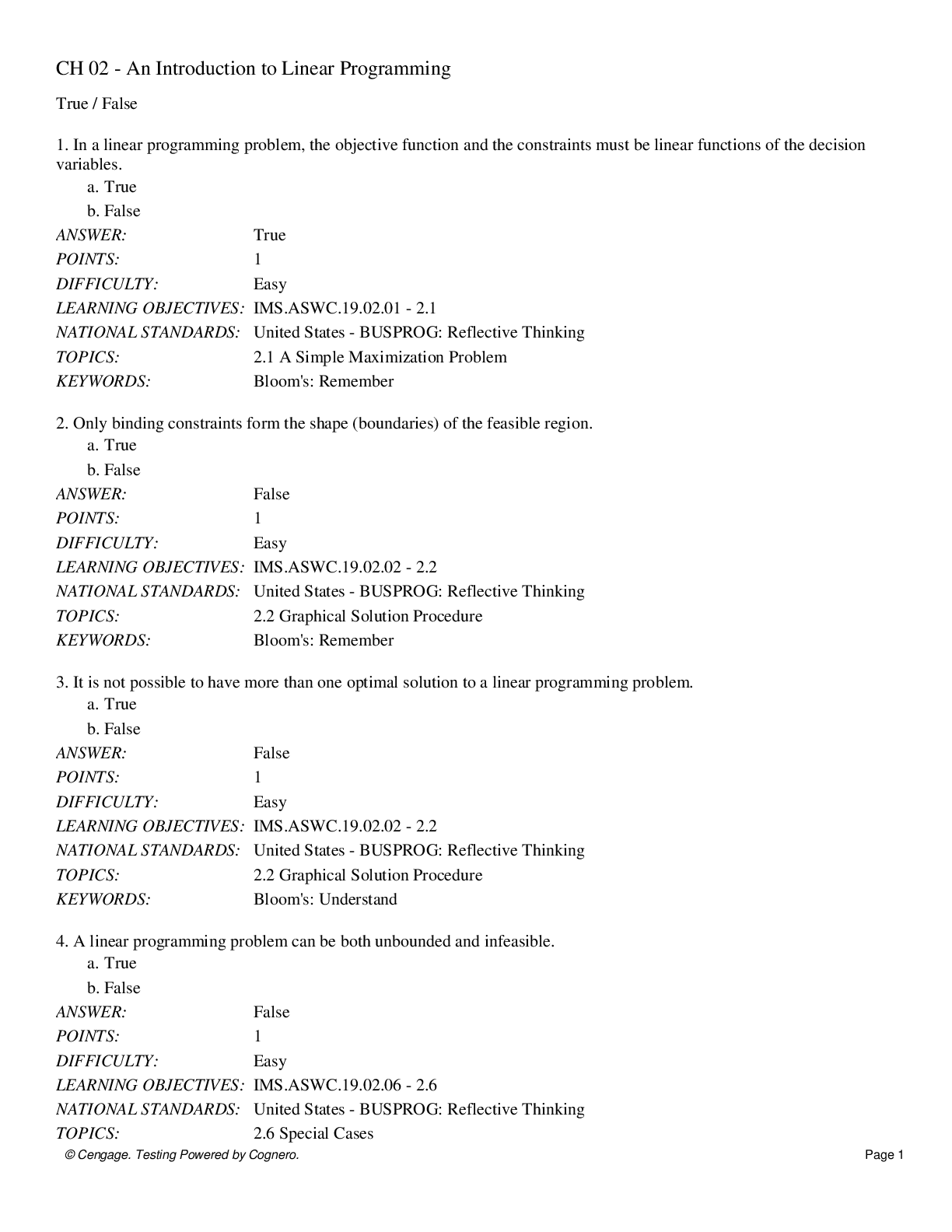
Reviews( 0 )
Document information
Connected school, study & course
About the document
Uploaded On
Nov 07, 2019
Number of pages
26
Written in
Additional information
This document has been written for:
Uploaded
Nov 07, 2019
Downloads
0
Views
91


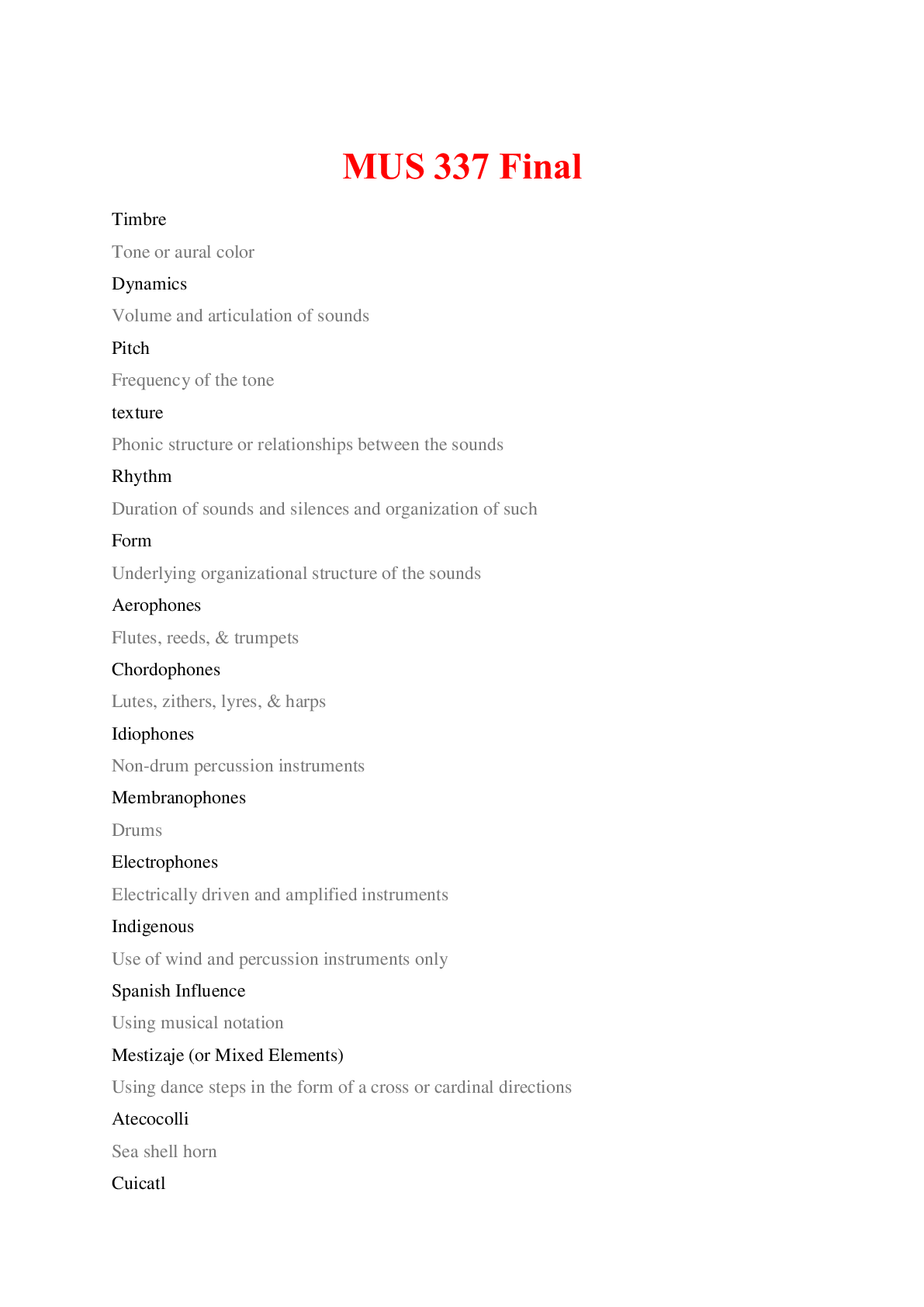







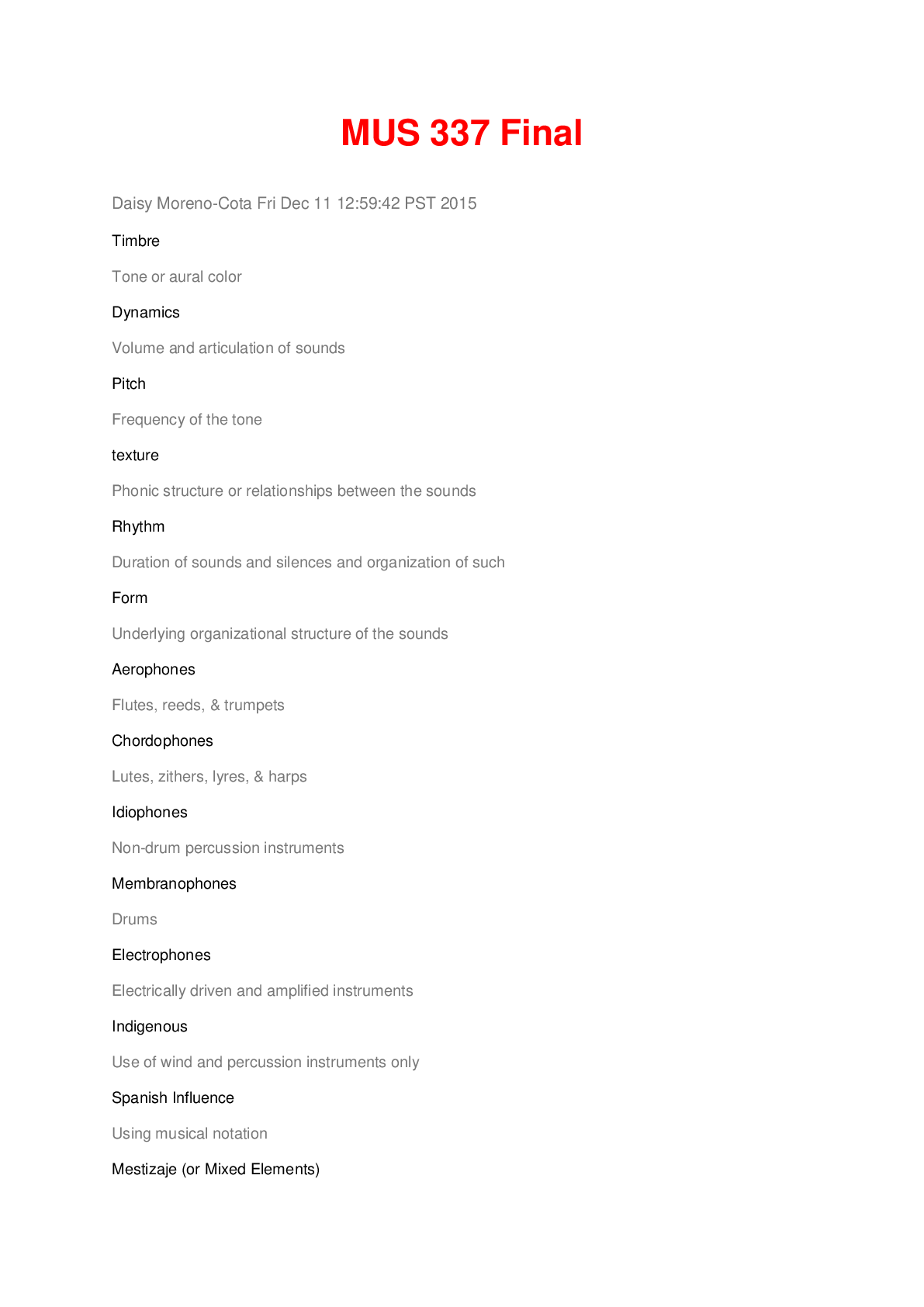




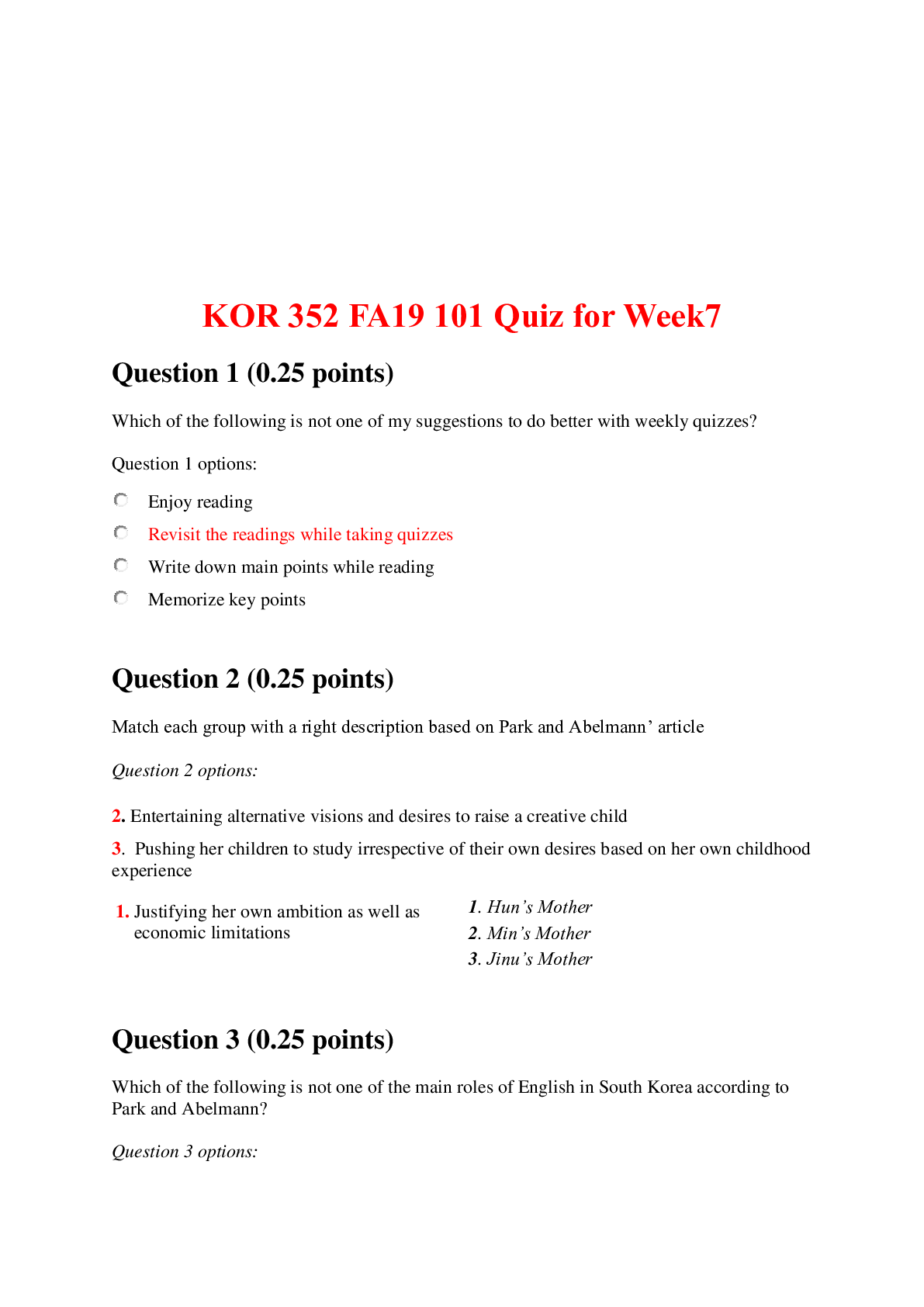



.png)
.png)
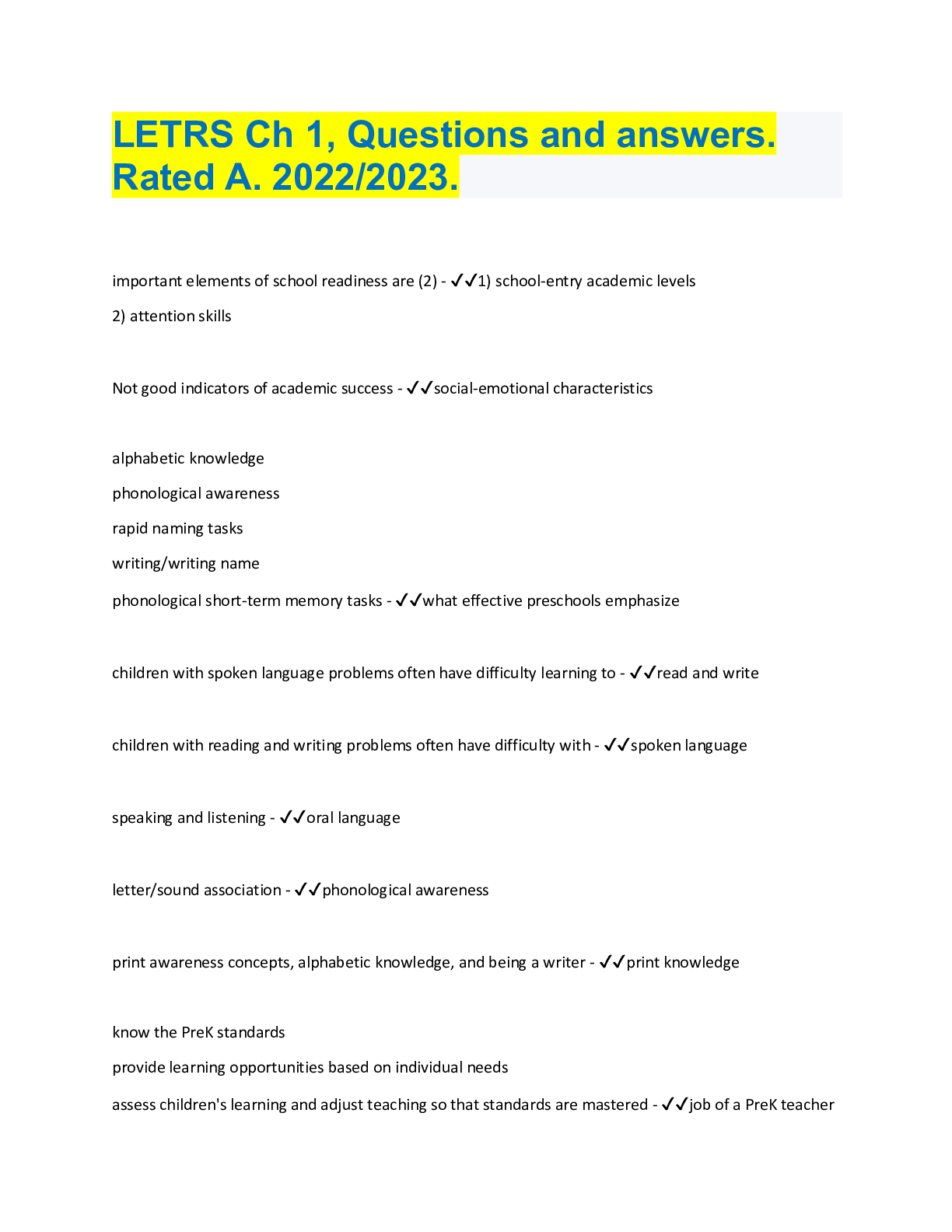
.png)
.png)
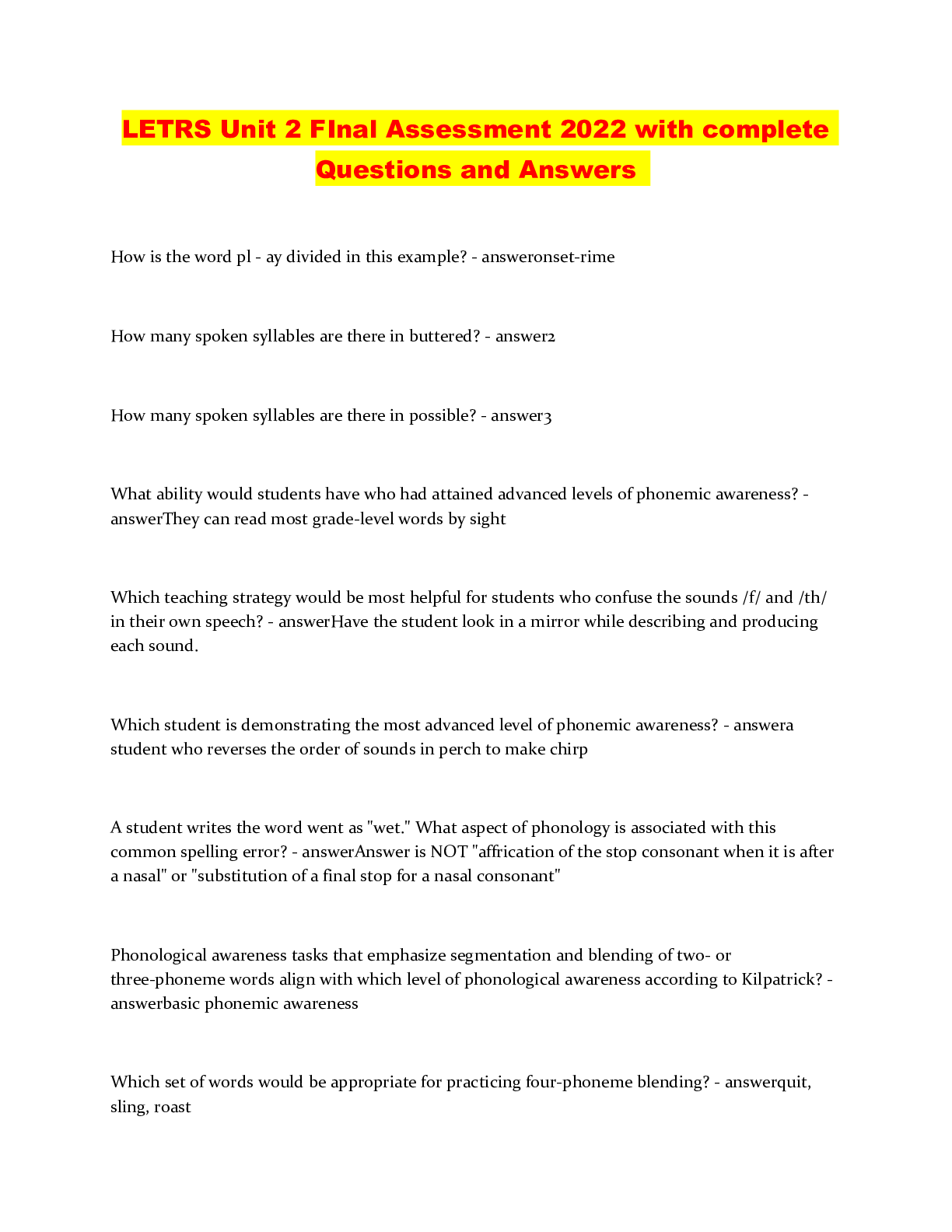


.png)
.png)
.png)
.png)
.png)




.png)

